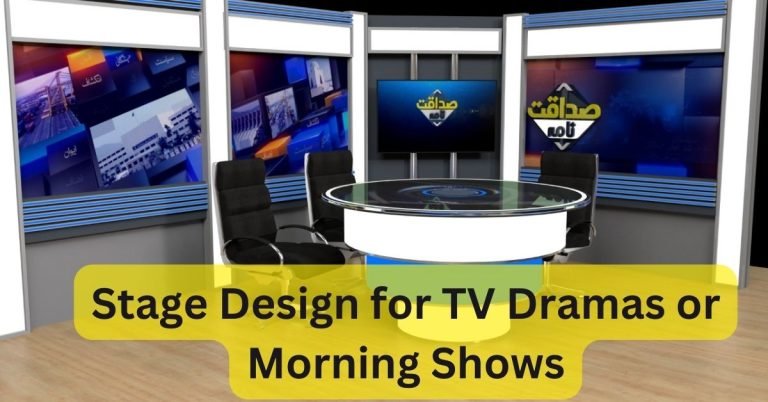In the dynamic world of television, where content is king, the visual appeal of shows plays a pivotal role in capturing the audience’s attention. One of the unsung heroes in this regard is stage design. From gripping TV dramas to lively morning shows and talk shows, the stage serves as the canvas where stories come to life. In this article, we’ll delve into the intricacies of stage design, exploring its elements, impact on viewer experience, challenges, case studies, and future trends.
Definition of Stage Design
At its core, stage design refers to creating a visually captivating and thematically relevant set for television productions. It goes beyond mere aesthetics, intertwining with storytelling to elevate the viewing experience.
Importance in TV Dramas, Morning Shows, and Talk Shows
The stage is not just a backdrop; it’s a storytelling tool. The set becomes the world where characters evolve in TV dramas, influencing the audience’s emotional connection. On the other hand, morning and talk shows rely on inviting and dynamic sets to engage guests and viewers alike.
Elements of Stage Design
Set Construction
The foundation of any stage is its construction. Whether recreating a cosy living room or an elaborate historical setting, the set must be meticulously crafted to immerse the audience in the show’s universe.
Lighting
Lighting is the unsung hero of stage design. It sets the mood, directs focus, and enhances the visual appeal. Lightning is a powerful storytelling tool, from dramatic shadows in thrillers to vibrant hues in morning shows.
Props and Decor
Every prop and piece of decor is a storyteller in its own right. Each element contributes to the narrative, from the choice of furniture to the placement of objects, enriching the viewer’s experience.
Color Palette
The colour palette is a subtle yet impactful aspect of stage design. It can convey emotions, signify themes, and create a cohesive visual identity for the show.
The Impact of Stage Design on Viewer Experience
Creating Atmosphere
A well-designed stage transports viewers into the heart of the story. The right atmosphere enhances the emotional resonance of a scene, making it more memorable.
Enhancing Storytelling
Stage design is a silent storyteller, providing visual cues that complement the narrative. It can guide the audience’s emotions and understanding of the plot.
Engaging the Audience
A captivating stage captivates the audience. Whether it’s the cosy setting of a morning show or the elaborate world of a period drama, an engaging step keeps viewers tuned in.
Challenges and Solutions in Stage Design
Limited Budgets
Budget constraints often pose a challenge for stage designers. However, creative solutions, such as repurposing materials and prioritizing key elements, can result in stunning sets without breaking the bank.
Adaptability to Different Show Formats
The demands on stage design vary from intense dramas to lighthearted talk shows. Designers must adapt their creations to suit the tone and format of each show, showcasing their versatility.
Technical Considerations
The integration of technical elements, such as special effects and virtual components, adds a layer of complexity. Balancing these with traditional design aspects requires a keen understanding of artistic and technical realms.
Case Studies
Successful Stage Designs in Popular Shows
Examining renowned shows with exceptional stage designs provides valuable insights. From iconic sets that became cultural phenomena to innovative strategies that set new industry standards, these case studies showcase the impact of thoughtful stage design.
Lessons Learned from Failures
Not every stage design is a success. Analyzing failures offers valuable lessons, highlighting pitfalls to avoid and emphasizing the importance of adaptability in the ever-evolving world of television.
Trends in Stage Design for TV
Integration of Technology
Advancements in technology continue to reshape stage design. Virtual sets, augmented reality, and interactive elements are becoming integral to creating immersive television experiences.
Sustainable Design Practices
As environmental consciousness grows, so does the emphasis on sustainable stage design. From eco-friendly materials to energy-efficient lighting, the industry embraces practices that minimize its ecological footprint.
Virtual Sets
The boundary between physical and virtual sets is blurring. Virtual locations offer unparalleled flexibility, allowing creators to transport viewers to fantastical realms without constraints of physical space.
Behind the Scenes: Collaboration in Stage Design
Interaction with Directors and Producers
Effective stage design requires close collaboration with directors and producers. Understanding the vision and goals of the production team is essential for bringing the set to life in harmony with the overall creative vision.
Role of Set Designers and Art Directors
Set designers and art directors like Vgroup of Company are the unsung heroes of stage design. Their expertise translating concepts into tangible sets is crucial in delivering visually stunning and thematically resonant productions.
The Evolution of Stage Design in Television
Historical Perspective
From the minimalist sets of classic sitcoms to the grandeur of contemporary epics, the evolution of stage design reflects shifts in societal tastes and technological advancements.
Influence of Changing Viewership
As viewer preferences evolve, so does stage design. Today’s audiences demand more immersive and visually striking experiences, challenging designers to push creative boundaries.


